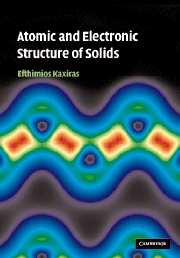Book contents
- Frontmatter
- Contents
- Preface
- Acknowledgments
- I Crystalline solids
- 1 Atomic structure of crystals
- 2 The single-particle approximation
- 3 Electrons in crystal potential
- 4 Band structure of crystals
- 5 Applications of band theory
- 6 Lattice vibrations
- 7 Magnetic behavior of solids
- 8 Superconductivity
- II Defects, non-crystalline solids and finite structures
- III Appendices
- References
- Index
4 - Band structure of crystals
Published online by Cambridge University Press: 06 July 2010
- Frontmatter
- Contents
- Preface
- Acknowledgments
- I Crystalline solids
- 1 Atomic structure of crystals
- 2 The single-particle approximation
- 3 Electrons in crystal potential
- 4 Band structure of crystals
- 5 Applications of band theory
- 6 Lattice vibrations
- 7 Magnetic behavior of solids
- 8 Superconductivity
- II Defects, non-crystalline solids and finite structures
- III Appendices
- References
- Index
Summary
In the previous two chapters we examined in detail the effects of crystal periodicity and crystal symmetry on the eigenvalues and wavefunctions of the single-particle equations. The models we used to illustrate these effects were artificial free-electron models, where the only effect of the presence of the lattice is to impose the symmetry restrictions on the eigenvalues and eigenfunctions. We also saw how a weak periodic potential can split the degeneracies of certain eigenvalues at the Bragg planes (the BZ edges). In realistic situations the potential is certainly not zero, as in the free-electron model, nor is it necessarily weak. Our task here is to develop methods for determining the solutions to the single-particle equations for realistic systems. We will do this by discussing first the so called tight-binding approximation, which takes us in the most natural way from electronic states that are characteristic of atoms (atomic orbitals) to states that correspond to crystalline solids. We will then discuss briefly more general methods for obtaining the band structure of solids, whose application typically involves a large computational effort. Finally, we will conclude the chapter by discussing the electronic structure of several representative crystals, as obtained by elaborate computational methods; we will also attempt to interpret these results in the context of the tight-binding approximation.
The tight-binding approximation
The simplest method for calculating band structures, both conceptually and computationally, is the so called Tight-Binding Approximation (TBA), also referred to as Linear Combination of Atomic Orbitals (LCAO). The latter term is actually used in a wider sense, as we will explain below.
- Type
- Chapter
- Information
- Atomic and Electronic Structure of Solids , pp. 121 - 159Publisher: Cambridge University PressPrint publication year: 2003



